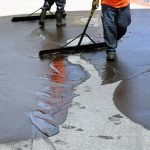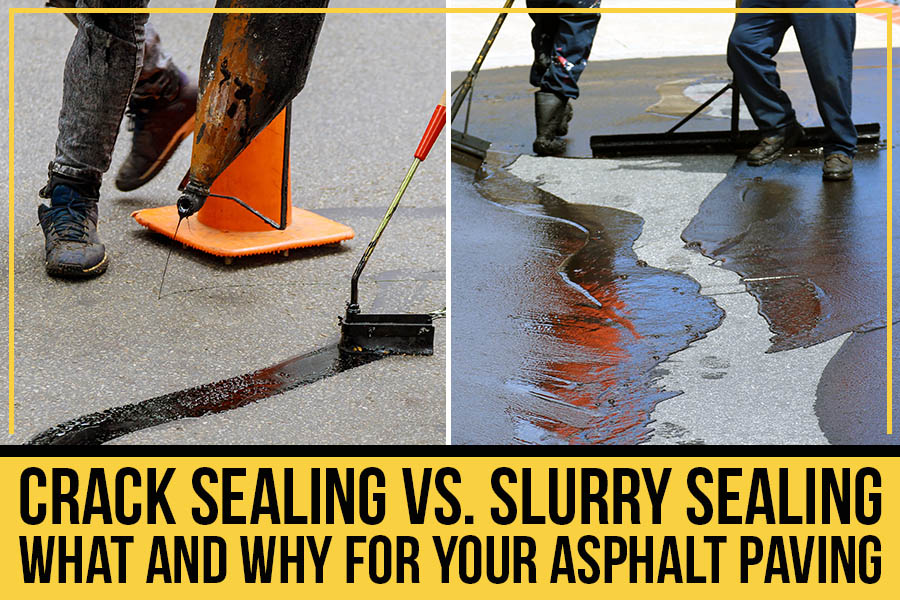Key takeaways:
- Crack sealing is an asphalt repair method for non-working cracks.
- It involves applying hot-pour rubberized asphalt sealant to the cracks.
- Slurry sealing consists of asphalt emulsion, water, and other additives.
- It works well for preventative maintenance and forms a barrier between the asphalt and the elements, but it will not fill cracks.
- If your asphalt pavement is showing cracks, it’s better to crack-fill them first and then apply a seal coat.
Table of Contents
ToggleIf you’re responsible for the upkeep of an area of asphalt paving, then you’ve likely heard of both crack sealing and slurry sealing. But what are they? And why should you care?
In this post, we’ll break down the basics of each procedure and outline what they mean for your asphalt crack repair needs. Scroll down for all the details.
Introducing Crack Sealing
You might have guessed from the name, but crack sealing is the process of sealing minor cracks in your asphalt. Why? Because left unchecked, those cracks will eventually turn into potholes or depressions in the surface of your asphalt.
Not only does this look bad, but it also accelerates the aging process of your asphalt pavement. It can lead to even more significant damage down the line.
After cleaning the crack in question, you apply a sealant to fill and seal it. This is usually done with a hot pour rubberized asphalt sealant, which bonds well to the asphalt and can flex with temperature changes.
What Is Slurry Sealing?
Slurry sealing is a similar process, but instead of just filling cracks, the entire surface of your asphalt is covered in a thin layer of material.
This material is usually a mixture of asphalt emulsion, water, and other additives. It’s applied using a machine that spreads the slurry evenly over the surface. Once it dries, it forms a new protective layer on your asphalt.
You can use this procedure for both preventive maintenance and asphalt repair. Sealing the surface prevents water and other materials from penetrating the asphalt and causing damage. It also smooths out the surface, making it less likely to develop cracks. And if your asphalt already has cracks, slurry sealing will help to fill them in and prevent further damage.
Why Choose Crack Sealing?
Now that we’ve discussed the basic know-how of crack sealing, you might wonder why you should bother with this repair method. For more on that, let’s evaluate the following:
No. 1: Longevity of Crack Sealing
The biggest reason to invest in crack sealing is for the longevity of your asphalt paving. By sealing the surface and filling in any cracks, you prevent water and other materials from penetrating the asphalt and causing damage. This simple repair can extend the life of your asphalt by years if not decades.
Without asphalt crack repair methods like crack sealing in place, your asphalt will quickly succumb to the elements and fall apart. Major faults like potholes and alligator cracks will form, and the surface will become uneven. In time, the damage will become so severe that the pavement will need complete replacement.
No. 2: Cost-Effectiveness of Crack Sealing
Taking time out to address every crack as soon as it forms may not seem like the most cost-effective solution in the short term. But in reality, it is. By investing a little time and money into asphalt repair now, you can save yourself a fortune down the line.
Replacing an entire asphalt paving surface doesn’t only swallow cash but hours of productivity as well. Your business or home can’t afford to be out of commission for days or weeks while new asphalt is being laid.
Crack sealing is a fast, effective, and affordable way to repair minor damage before it snowballs into something much worse.
Why Choose Slurry Sealing?
You might ask that if crack sealing is so amazing, why bother with slurry sealing?
No. 1: Prevention
Crack sealing works well as a preventative measure. By sealing cracks early, you can stop moisture and water from seeping in and causing even more damage.
However, it’s good to prepare before cracks start popping up. That’s where slurry sealing comes in.
Slurry sealing is a preventative measure that will help extend your asphalt’s life by protecting it from weathering, oxidation, and water damage.
It does this by creating a barrier on the surface of the asphalt that will deflect UV rays, resist water penetration, and provide a safe surface for pedestrians and vehicles.
No. 2: Aesthetics
An asphalt paving dotted with crack sealing might be necessary, but it doesn’t have to look bad. Slurry sealing can improve the appearance of your asphalt by filling in irregularities and creating a smooth, consistent surface.
This can be a big selling point if you’re trying to attract customers to your business or draw people to your event. First impressions matter, after all.
And with that smooth surface, you can be sure of traction and slip-resistance for pedestrians and vehicles alike. No one wants to risk slipping and falling, especially if they carry something fragile.

When Should I Consider Crack Sealing?
Crack sealing is a procedure best suited to non-working cracks, which are cracks in the asphalt pavement with movements less than 0.1 inches wide. These cracks are typically found in the expansion joints between slabs. Still, they can also be found around control or perimeter joints.
Working cracks with movements more significant than 0.1 inches will not respond to crack sealing and will require more significant repair. These cracks are often caused by heavy vehicles driving over the surface of the asphalt, so they will likely appear in parking lots or on roadways.
When Should I Consider Slurry Sealing?
While crack sealing is excellent for asphalt crack repair, slurry sealing serves a different purpose. Slurry sealing is a mixture of asphalt emulsion and fine aggregate spread over the surface of asphalt paving.
This seal coat is typically applied to pavements that show wear and tear but do not yet have significant structural damage. Thus, if your pavement has cracks, it might be better first to crack seal and then perform slurry sealing.
To achieve the best results in your asphalt repair, check out Forbes‘ guide to finding the best asphalt paving contractor.
Conclusion
That was our simple guide to slurry sealing vs. crack sealing. We hope it helped you better understand asphalt crack repair methods and when to use them. For more on asphalt maintenance, check out our blog on tips for porous asphalt pavement.
We at Landmark are proud to serve and Oviedo, FL, with ready and reliable asphalt paving services. Our team of experienced professionals is here to help you every step of the way.




